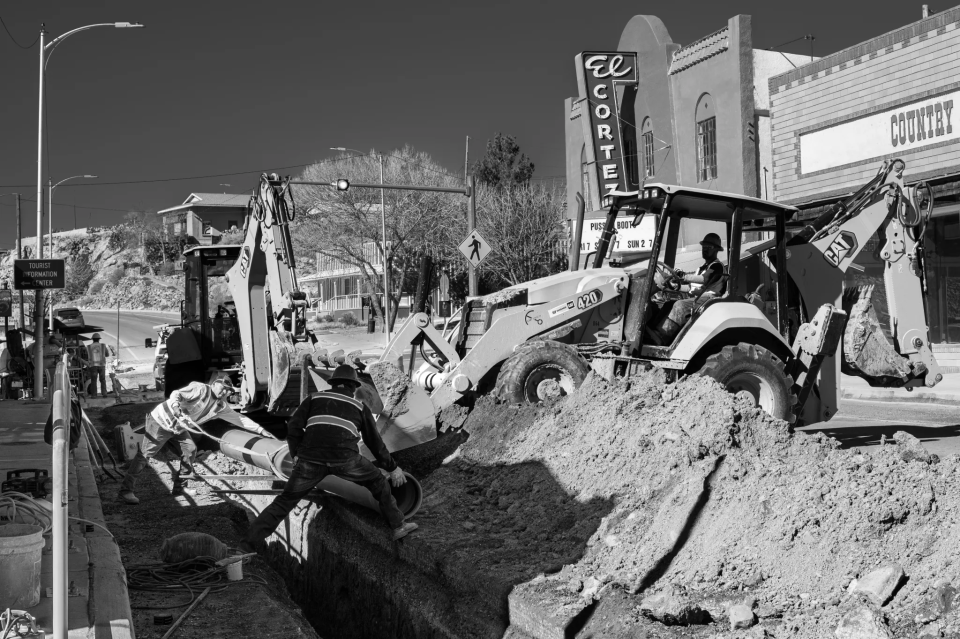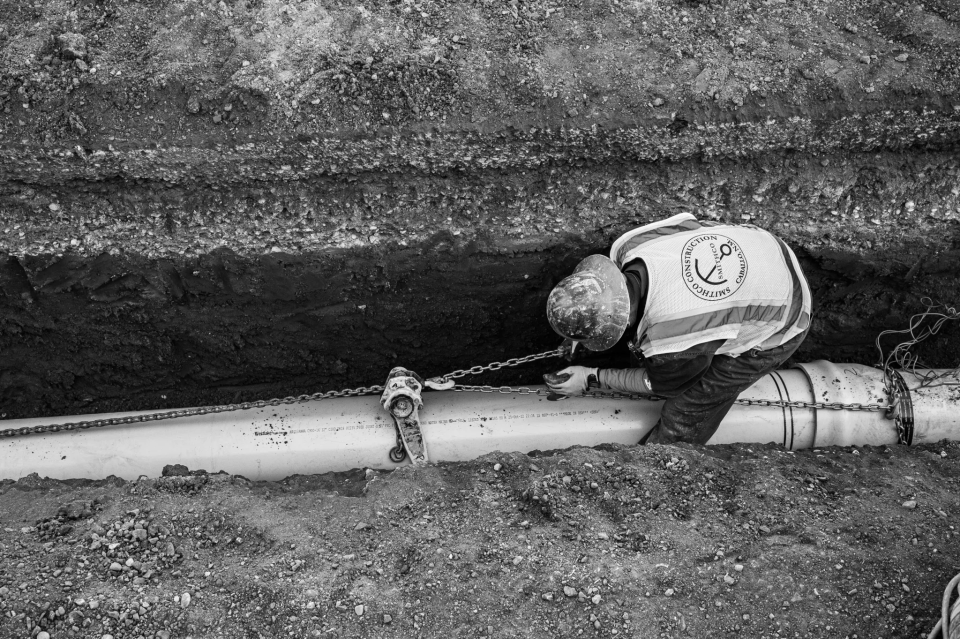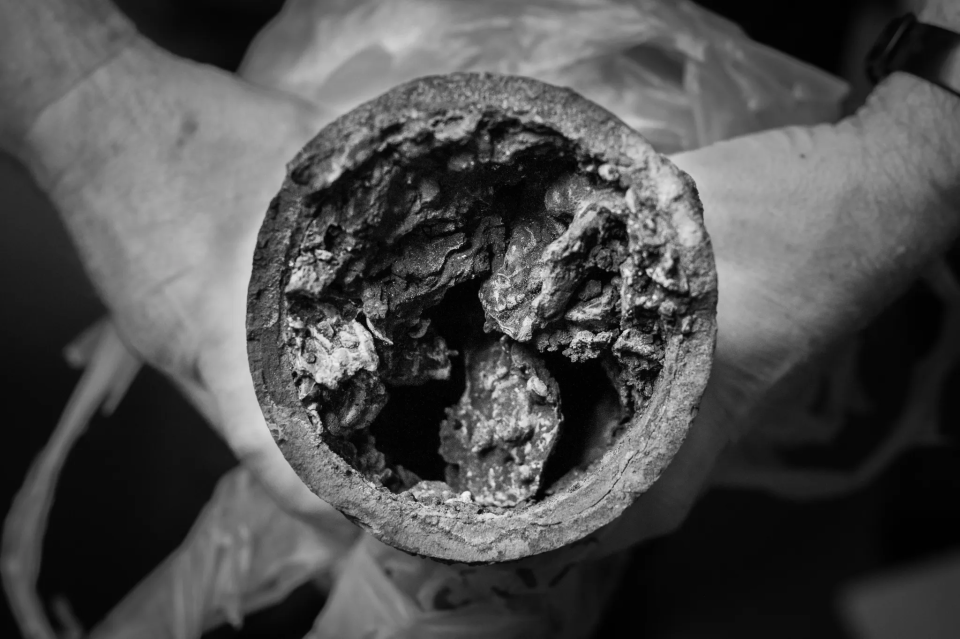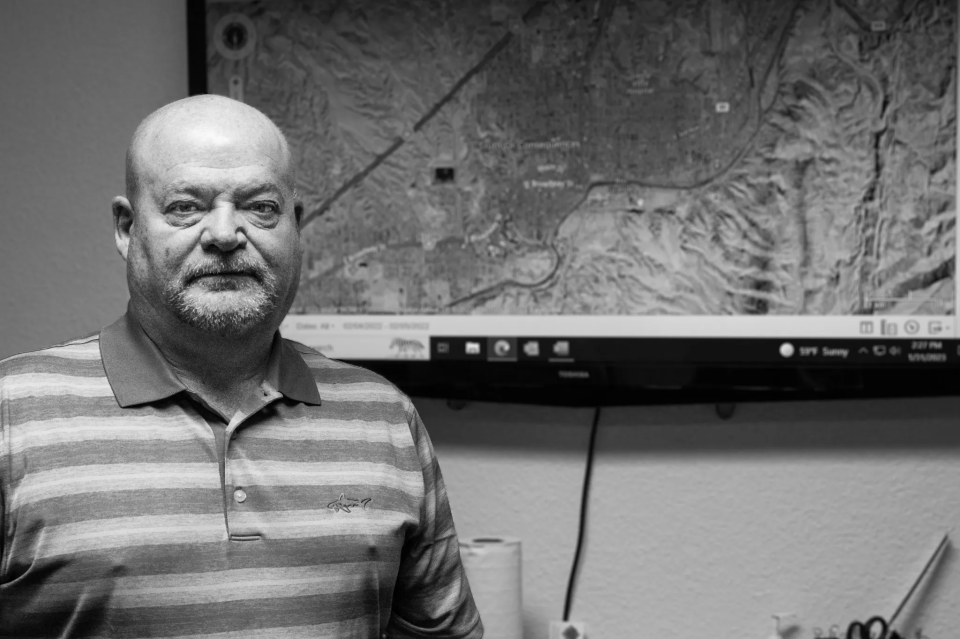In drought-plagued New Mexico, a city loses nearly half its water - to leaky pipes
Set on the northern bank of the Rio Grande, along a bend in the river about 150 miles south of Albuquerque, the city of Truth or Consequences is home to some 6,000 people. Neighborhoods of single-story houses and mobile homes fan out from a historic downtown district with galleries and restaurants, a local pharmacy and a grocery, and the visitor center for Spaceport America.
Since at least the late 19th century, the area has been known for its natural hot springs, and T or C still promotes itself as a low-key thermal resort town. “Most people who come here are on a magical getaway of some kind,” said John Masterson, co-owner of the Truth or Consequences Brewing Company.
Far less magical is what’s happening beneath the ground. About half of T or C’s water supply lines are more than 50 years old; some date to the 1930s, according to a 2021 engineering report. Many are “beyond their expected useful life,” the report notes.
The result: leaks, and lots of them.

In 2022, over 200 million gallons — a staggering 43 percent of the water in the system — was lost to leakage, according to T or C’s city manager, Bruce Swingle. Three years earlier, losses were at 28 percent. Not only does this show how quickly the system has been deteriorating, but “it’s a sign of things to come,” Swingle said during an interview at his office.
Line breaks in the fragile system are a near-daily event, with over 400 repairs made last year. As soon as one section is fixed, Swingle said, “the water finds the next most vulnerable spot” and bursts through it, like an endless game of water-line Whac-a-Mole. “We’ve had cars drive into sinkholes” after subsurface seepages destabilized the ground, he added.
While some residents accept the leaks and related water outages with patience, believing the city is doing the best it can, a certain amount of frustration is unavoidable. “Unless there’s a geyser coming out of the ground, it’s not a priority to the city,” local artist June Jewell wrote in an email. Last year there was a leak in front of her house for four months, she elaborated, adding that since September there’s also been “a steady flow of water 24/7” from another leak down the block.
Robin McBroom, who has lived in T or C for less than a year, is “worried that the whole system is going to go down.” There are leaks all the time, she said, which can “make a little lake in the middle of the street.” Still, she’s happy about her move. “This is where I’ve always wanted to retire. I’d buy a 500-gallon water tank and hook it up if I had to.”
From its six wells, the city annually pumps 475 million gallons of water, which is also piped to the adjacent village of Williamsburg and its 500 residents. Utility crews are constantly performing triage, applying one Band-Aid after another to a water system that needs major surgery.
Two areas of town — the east side and the so-called metal streets, with names like Nickel and Tin — are in “critical condition,” Swingle said. “We have to replace those lines as soon as possible. It’s literally a crisis, and it’s only going to get worse in the next few months.” If nothing is done, the city faces system-wide failure.
Replacing those lines will cost an estimated $20 million, engineers have concluded. Performing all of the improvements that the system needs has a price tag closer to $150 million. T or C cannot afford either option. And it is not alone.

Widespread problem, few solutions
In drought-ridden New Mexico, concerns about water supply are paramount, yet hundreds of water utilities have urgent infrastructure needs and almost no way to pay for them. Smaller systems are affected disproportionately, and two-thirds of the state’s water systems serve 500 people or fewer.
Revenue from user rates in these small communities is dwarfed by the costs of the needed upgrades. And the process for obtaining grants and loans is prohibitively baroque for smaller systems to pursue.
“The state’s water finance system is fragmented and lacks a consistent strategy or goal,” the Legislative Finance Committee reported in 2021, casting the problem in dire terms. New Mexico’s water infrastructure (including wastewater systems) likely needs more than $2.8 billion in repairs, the LFC concluded.
Additionally, the LFC found that funding is too often provided piecemeal, which increases the risk that work will flounder or stall indefinitely because the money runs out. In the village of Maxwell, south of Raton, for example, a $1 million well project was stymied by a budget shortfall of about $30,000, the LFC found.
Problems like this also plague water systems around the country, according to a 2021 “report card” issued by the American Society of Civil Engineers. “There is a water main break every two minutes and an estimated 6 billion gallons of treated water are lost each day in the United States,” the group found.

Financial drains
How was the water system in T or C allowed to deteriorate to such a degree of disrepair? “I think it’s a case of out of sight, out of mind,” said T or C’s fire chief, Paul Tooley, who joined the volunteer department 40 years ago and has led it since 2009. As long as water continued to flow, small problems buried underground could be overlooked while the city’s budget was channeled toward other priorities.
But the situation in which T or C now finds itself is also a result of past budgetary decisions.
Water utilities are intended to function as “enterprise systems,” according to the LFC, meaning that revenue from customers should cover the costs of operations and maintenance. Any money unspent at the end of a fiscal year, it adds, should be set aside for future projects.
T or C, however, has habitually moved income earned by its water utility into its general fund, to be spent on other things, depleting its reserves, budget documents show. Using ratepayer money for anything other than its intended purpose is generally discouraged; in some parts of the country, it’s even been outlawed.The practice can “conceal poor budgeting, ineffective planning, and other mismanagement that could spell disaster for the city and/or its utilities in the long term,” according to the city of Elkins, West Virginia, which is about the same size as T or C, and where such transfers are illegal.
Swingle, who has been in his position for less than two years, said he has raised this issue with T or C’s city commissioners. “It’s going to be corrected,” he said. But he said he is more interested in focusing on what comes next than in reviewing past decisions. “Let’s not point fingers, let’s solve the problem.”
That won’t be easy. Though Swingle isn’t daunted by the scope of the work, finding enough money to move forward poses a major challenge.
Currently, water lines in the downtown district are being replaced with the help of a $3.9 million rural development grant from the U.S. Department of Agriculture, along with a $5.4 million loan that the city obtained from the local Bank of the Southwest, Swingle said. None of that work will touch the two neighborhoods that are in critical condition, and it will barely make a dent in the city’s overall needs.
In the past couple of years, T or C has raised water prices by more than 30 percent to increase revenue for operations and improvements. Voters approved a bond measure last November to provide $1 million for water infrastructure. And the city has asked U.S. Sen. Martin Heinrich for $54 million in federal appropriations to address the problems. But thus far Senator Heinrich has only been able to provide $1.6 million to “get the ball moving,” according to his office.
Though water utilities in New Mexico can apply for funding from several state agencies, T or C has exhausted those avenues, said Swingle, and it cannot take on any more debt. With its options dwindling and its water system rapidly degrading, it needs what amounts to a bailout by the state legislature or the federal government.

Wanted: Pools of money
T or C’s last best hope to avoid disaster is an infusion of cash drawn from the pools of discretionary monies that the governor and state legislators can use to fund high-priority projects. On February 10, Swingle and State Sen. Crystal Diamond said they met with Gov. Michelle Lujan Grisham to ask for $19 million, to which Diamond pledged to add $1 million — about one-third of the total capital outlay that the senator guesses she will be able to distribute this year, which she needs to spread among constituents in four counties. (The governor could not immediately be reached for comment.)
“We can’t kick the can down the road on this anymore,” Diamond said during an interview at the Roundhouse. “This is time-sensitive; it’s a basic need for our community.” Noting that the state expects a budget surplus in the range of $3.5 billion to $4 billion, she said that the best way to spend the windfall is on infrastructure.
State Rep. Gail Armstrong, whose district includes T or C, agrees that spending on infrastructure should be the top priority. But her optimism is muted. “There’s all this money now and everyone wants it. There’s a priority list, and a waiting list, and other communities that also have critical infrastructure needs. Hopefully, the situation in T or C doesn’t become a crazy emergency.”
For Swingle, patience is not an option. “We don’t have years to deal with this,” he said. “There are fewer problems in winter. In a few months, that’s when you’ll see catastrophic failure.”
Michael Benanav is a writer, photographer and digital storyteller based in northern New Mexico. In addition to Searchlight, his work appears in The New York Times, The Christian Science Monitor, Sierra... More by Michael Benanav
This article originally appeared on Las Cruces Sun-News: In drought-plagued New Mexico, a city loses nearly half its water - to leaky pipes

